Best Knife Sharpeners for Chef’s Knives
We tried electric and manual models from Chef’s Choice, Presto, Wasabi Knives, and others to determine which put the best edge on a chef’s knife
A dozen passes on the best sharpeners left our test knives razor sharp and capable of slicing a tomato with ease.
By Paul Hope
As long as I can remember, I’ve been obsessed with the idea of a sharp knife. My dad, a former butcher, taught me to sharpen knives, starting around age 6. We used his sharpening stone, which he kept at my grandma’s house in upstate New York, when we visited her on weekends. There I learned first on a small Swiss Army knife before I was allowed to practice on her larger boning and chef’s knives.
Since then, I’ve used hundreds of knives—in culinary school, in professional kitchens, and now at home, as the resident chef—and I can tell you that the real magic isn’t always in the knife so much as in the sharpening. That’s not to say any knife is fine—we found significant differences and clear favorites in CR’s evaluation of chef’s knives. But I’d rather cut with a crummy knife that has been recently sharpened than a stellar knife with a dull blade.
How We Picked the Knife Sharpeners
To find the best knife sharpeners to test, I considered models that distinctly differed in design—from conventional retail offerings (like electric countertop and manual sharpeners from big brands, such as Chef’s Choice and Presto) to traditional whetstone. In each case, I scoured the internet to find the top-selling sharpeners that home cooks seem to love.
Finally, I included the Wasabi Knives Iki Ruixin Pro—a medieval-torture-like device that has been continually cropping up in my Instagram feed—and the Work Sharp Precision Adjust Knife sharpener, which is similar in principle to the Wasabi but costs about $60 less.
How We Evaluated Knife Sharpeners
To achieve consistent results, I used two standout knives from our recent test of the best chef’s knives: the J.A. Henckels Forged Premio 8-inch Chef’s Knife, a German-style knife factory-sharpened to 15 degrees; and the Global G-2 8-inch Chef’s Knife, a Japanese blade factory-sharpened to between 10 and 15 degrees.
Because I needed to start with dull blades, I dragged each knife horizontally across a honing rod 25 times, cringing every moment, until the blade was so dull you’d barely be able to cut cooked pasta with it.
One at a time, I sharpened each knife with each sharpener, then evaluated how fine the blade’s edge felt by dicing onions and cutting translucent slices of Roma tomatoes. Even though I couldn’t measure the exact angle each model turned out, plowing through bags of produce made it abundantly clear which knives had been sharpened to a razor edge.
I also used each newly sharpened knife to cut thin curls of computer paper, because it’s the telltale test for a sharp knife (and frankly, it’s really fun to do). Admittedly, I went a little overboard—I ended up with so many little nests of shredded paper that my partner said our kitchen looked as if it had been infested with mice. Once I was done with one sharpener, I dulled the knives again before moving on. Here’s what I found.
The Best Knife Sharpeners (and the Worst)
Every sharpener I tried did at least a decent job of returning an edge to both knives. But some sharpeners clearly produced a finer edge than others, and a handful were tedious to use. At times, some even felt dangerous.
Editor’s Choice: Chef’s Choice Model 15XV 3-Stage Professional Electric Knife Sharpener
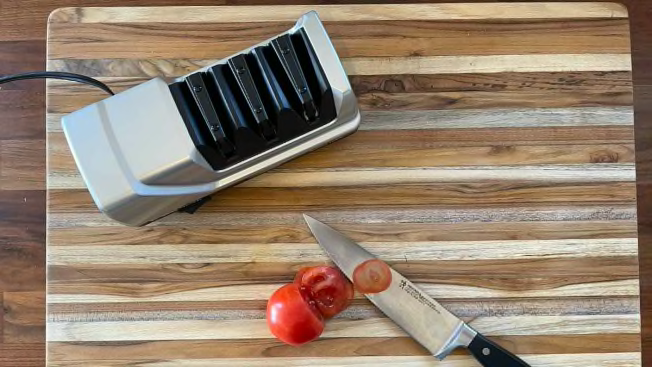
Photo: Paul Hope/Consumer Reports
Price: From $160
Where to buy: Amazon, Sur La Table, Walmart
The Chef’s Choice Model 15XV is second to none when it comes to easy, complete sharpening. It removes most of the guesswork and helps you maintain a perfect angle, and it can sharpen pretty much any knife you’ll ever own—even serrated bread knives or sushi and sashimi knives, which are sharpened on only one side.
The tool is designed to sharpen every straight-edged knife to a precise 15-degree angle, which is a sweet spot for most new knives. It features three settings: sharpening, honing, and polishing. There’s no setup, no cleanup, and no stress.
Read our full review of the Chef’s Choice Model 15XV.
Best Manual Knife Sharpener: Chef’s Choice Model 4643 AngleSelect Professional Manual Knife Sharpener
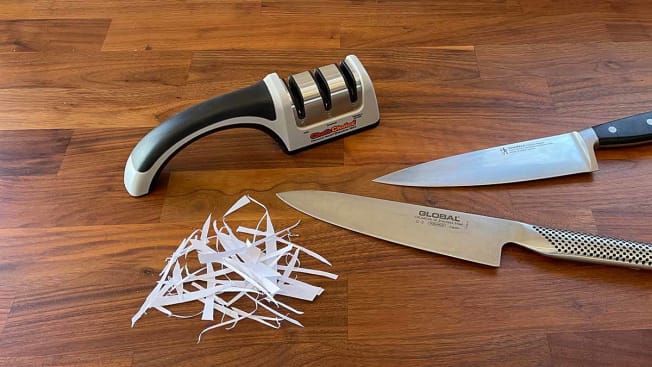
Photo: Paul Hope/Consumer Reports
Price: From $42
Where to buy: Amazon, Chef’s Choice
The Chef’s Choice 4643 looks like the analog version of the brand’s electric sharpener. But unlike the electric model XV, which sharpens every knife to a 15-degree angle, this sharpener has two basic sharpening settings, one for sharpening knives to 15 degrees, and another for sharpening knives to 20. Many new German and Japanese knives (including those we used) come factory-sharpened to finer angles than in the past, so check with the manufacturer to see what angle it recommends.
A third stage polishes the edge on any knife, regardless of which sharpening angle you choose.
Like the brand’s electric sharpener, the 4643 feels well-designed, with grooves that hold your knife at the perfect angle as you slowly drag it through the stage. Both knives I sharpened emerged exceptionally sharp—even when I sharpened the Henckels on the broader 20-degree setting—making this a perfect pick if you feel apprehensive about using an electric sharpener or are just looking to save money and real estate on your countertop or in the cabinet.
Best Budget Manual Knife Sharpener: KitchenIQ Deluxe Diamond Edge Grip 2-Stage Knife Sharpener
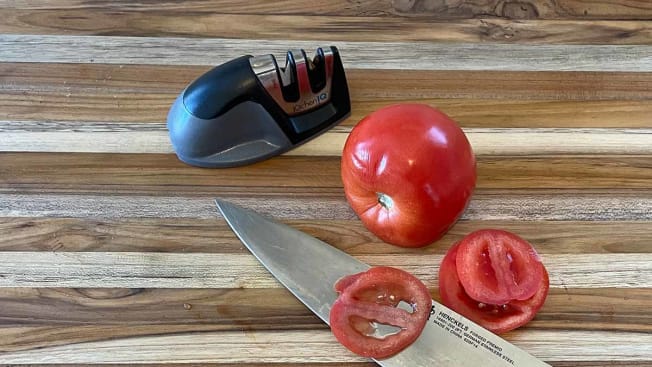
Photo: Paul Hope/Consumer Reports
Price: From $11
Where to buy: Amazon, Walmart
It’s hard to believe that this mouse-sized sharpener can put an edge on a knife, but it does.
The KitchenIQ is a simple sharpener with two stages. The coarse stage is for damaged or seriously dull knives, while the fine slot is for a knife that has just lost its edge.
The angles are set for European-style knives—KitchenIQ doesn’t specify the exact angle—but I still found that both my German and Japanese knives emerged with a sharp edge that allowed it to effortlessly slice through onions and tomatoes. The sharpener can be held flat on a countertop, but it also has a notch on the underside, so you can position and hold it on the edge of your counters, too. It’s extremely helpful for quick sharpenings and easily fits in a drawer. One caveat: Because it’s so small, your fingers end up quite close to your knife as you’re sharpening. The manual Chef’s Choice, above, is a better bet if you’re worried about potential mishaps.
Best Sharpening Stone: Sharp Pebble Premium Whetstone Knife Sharpening Stone
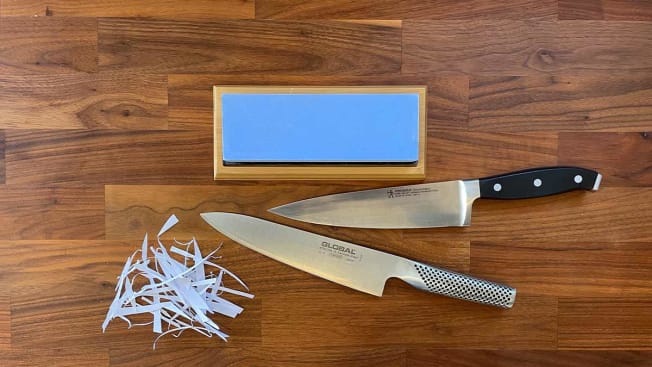
Photo: Paul Hope/Consumer Reports
Price: From $40
Where to buy: Amazon, Sharp Pebble, Walmart
The Pebble Premium is a double-sided sharpening stone: It’s 1,000-grit on the coarser side, and 6,000 on the finer side—perfect for sharpening and polishing a moderately dull knife. However, you’ll need a coarser grit (indicated by a value below 1,000) to reshape the edge of a seriously dull knife. Sharp Pebble also sells a 400-grit stone for about $28.
If you enjoy the sharpening process or demand precision, this might be the way to go. It gives you the most control of any option here— allowing you to sharpen any knife to the exact angle you want. (A tool called a bevel gauge, sold at hardware stores, can help you find that angle.) The stone needs a 10- to 12-minute soak before you work, so it’s best to sharpen all your knives at once. It put an edge on both of our knives that none of the electric or manual sharpeners could match, and I found the process relaxing.
Read our full review of the Sharp Pebble Premium Whetstone Knife Sharpening Stone.
AccuSharp Knife & Tool Sharpener
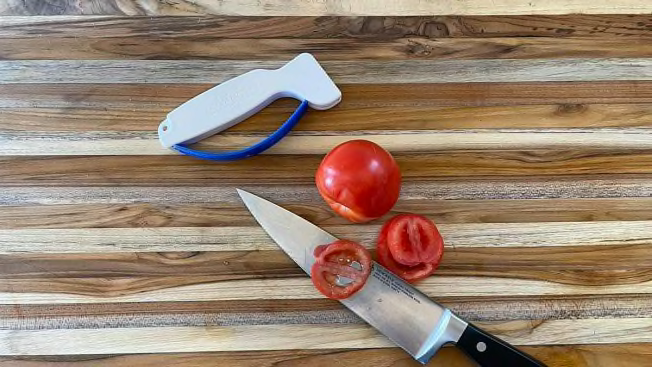
Photo: Paul Hope/Consumer Reports
Price: From $11
Where to buy: Amazon, Bed Bath & Beyond, Walmart
The AccuSharp differs from most of the options here, in large part because it’s designed to tackle tool blades in addition to knives.
For sharpening knives, it has one glaring shortcoming: You use the sharpener by holding a knife steady, blade up, on your countertop. Then you drag the sword-handle-shaped sharpener across the edge of your knife while applying downward pressure. It’s easy to see how a single misstep could end poorly. The sharpener certainly works, but it feels more aggressive than the fine settings you’ll see on other manual sharpeners, leaving you with the feeling that you’re shaving off more metal than you need to in order to restore an edge (though it would take at least a year to know whether that has happened for sure).
While it feels aggressive for chef’s knives, AccuSharp claims the tool can also sharpen lawn mower blades, axes, and machetes (?!), making it a potentially valuable tool in your garage, if not your kitchen.
Presto EverSharp Electric Knife Sharpener
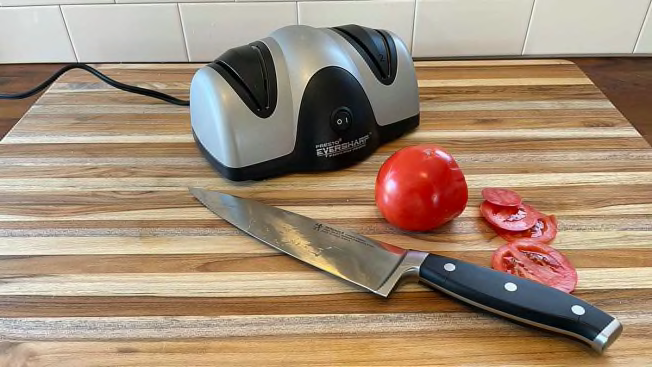
Photo: Paul Hope/Consumer Reports
Price: From $45
Where to buy: Amazon, Target, Walmart
The Presto EverSharp produces sharp knives, even if it lacks the refinement of the Chef’s Choice electric sharpener. It features two sharpening stages instead of three and can’t be used on serrated knives. And somehow, it felt both overly aggressive in terms of how much metal it removes—yet underpowered. It bogged down several times, stopping the motor entirely until I removed the knife from the guides and started again.
The first stage of the sharpener also seemed to remove so much metal that even a split-second pause resulted in a small dip at the back of the blades, where the sharpener took off more metal than I would have liked (shown below). Aside from the inconvenience of having to even out the edge, a sharpener that removes too much metal ultimately shortens the life of your knife.
That said, it’s about a third of the price of the Chef’s Choice electric sharpener, and after the initial learning curve, I got better at using it. If you have a cheaper set of knives, it would certainly work, but for the money, you might be better off with one of the manual sharpeners we tested.
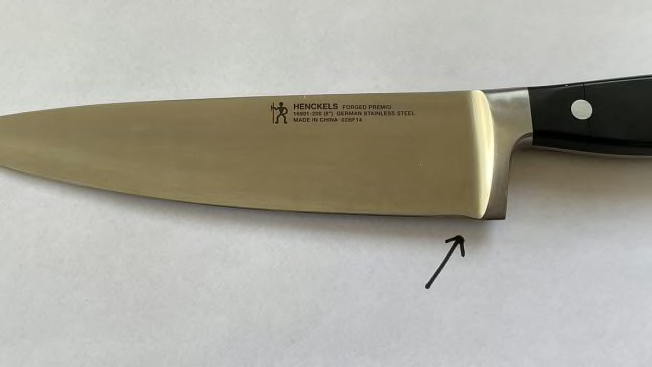
A split-second pause when sharpening resulted in a small dip forming at the back of blade.
Photo: Paul Hope/Consumer Reports
Wasabi Knives Iki Ruixin Pro Sharpener + 4 Whetstones Set
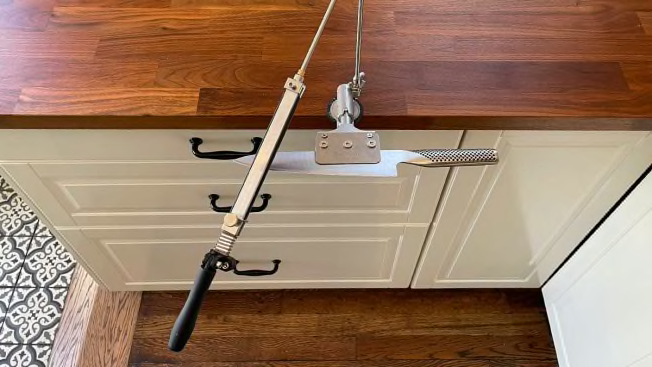
Photo: Paul Hope/Consumer Reports
Price: From $119
Where to buy: Wasabi
The Wasabi Knives Iki Ruixin Pro arrives as little more than a bag of metal rods and clamps, and at times, I thought I should have left it that way. After a fairly tricky assembly, you’re left with a sharpener that resembles an erector set, clamped to the edge of your counter. The Ruixin Pro is basically a sharpening stone in reverse—you mount your knife into the sharpener, then use the tool to drag a series of ever-finer sharpening stones across the edge of the blade.
Between assembly, soaking the sharpening stones, and mounting the knife in the tool—which requires loosening and tightening five fasteners—it took me 15 to 20 minutes to even start sharpening. You also need to use a level app or a digital level to adjust the Ruixin Pro to the correct angle for each knife you sharpen. To say the process is cumbersome is generous. But the knives did emerge exceptionally sharp, akin to the results we got from our sharpening stone. So I can see the Ruixin Pro’s appeal for someone who loves to tinker. If you buy one, set it up where you can keep it permanently assembled, thereby avoiding the aggravation of set-up each time your knife loses its edge.
Read our full review of the Wasabi Iki Ruixin Pro Sharpener + 4 Whetstones Set.
Work Sharp Precision Adjust Knife Sharpener
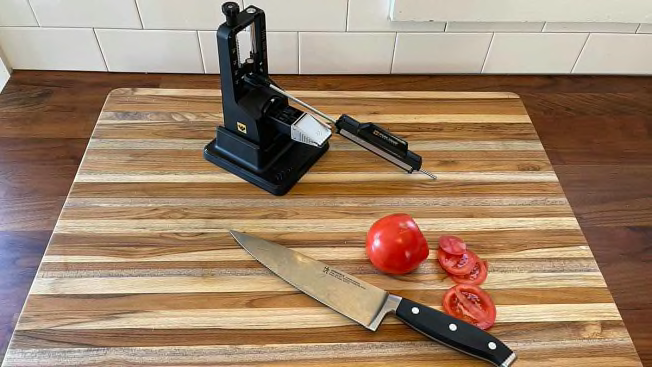
Photo: Paul Hope/Consumer Reports
Price: From $60
Where to buy: Amazon, Work Sharp
The Work Sharp operates on the same premise as the Wasabi, above, in that you clamp your knife to the tool, then drag a series of stones across the edge of the blade. But unlike the Wasabi, this tool feels polished and ready for prime time. There’s only about 30 seconds of assembly, and all the parts are attached to the tool. You clamp your knife to the sharpener with a simple dial (instead of a network of five screws), and even the sharpening stones are permanently attached—there are three in total, and you can rotate between them to adjust the coarseness. These stones (unlike those used on the Wasabi) don’t need to be soaked in water before each use.
The one downside: The Work Sharp felt a bit small for an 8-inch chef’s knife: I had to steady the sharpener so it wouldn’t tip over—not dangerous per se, but annoying. To adjust your sharpening angle, you simply rotate a dial that automatically raises and lowers the stone; there are numbers printed on the tool, so you know exactly what angle you’re getting without the need to use a separate level.
All in all, it’s an effective tool, but I still can’t help but think the Work Sharp, much like the Wasabi, is much more complicated than it needs to be. Both tools certainly work to sharpen knives, but in the time it takes to familiarize yourself with the tool, you could master sharpening knives on a stone.
This product evaluation is part of Consumer Reports’ Outside the Labs review program, which is separate from our laboratory testing and ratings. Our Outside the Labs reviews are performed at home and in other native settings by individuals, including our journalists, with deep subject matter experience or knowledge and are designed to offer another important perspective for consumers as they shop. While the products or services mentioned in this article might not currently be in CR’s ratings, they might eventually be tested in our laboratories and rated according to an objective, scientific protocol.
Like all CR evaluations of products and services, our Outside the Labs reviews are independent and free from advertising. If you’d like to learn more about the criteria for our lab testing, please go to the Research & Testing page on our website.
Consumer Reports is an independent, nonprofit organization that works side by side with consumers to create a fairer, safer, and healthier world. CR does not endorse products or services, and does not accept advertising. Copyright © 2023, Consumer Reports, Inc.
